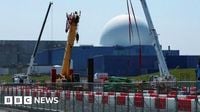The UK government has given the final green light to the Sizewell C nuclear power plant, marking a pivotal moment in the nation's energy strategy. Announced on July 22, 2025, this £38 billion project aims to bolster the UK’s energy security and climate goals by providing clean, homegrown power to millions of homes for decades to come.
Located on the Suffolk coast in eastern England, Sizewell C is set to become Britain's largest nuclear power project in a generation. The government, now the largest shareholder with a 44.9 percent stake, has partnered with a coalition of private investors, including Canadian pension fund La Caisse (20 percent), British Gas owner Centrica (15 percent), investment manager Amber Infrastructure (7.6 percent), and French state-owned energy giant EDF (12.5 percent). This diverse consortium reflects a significant public-private partnership designed to share the financial burden and risks associated with such a massive infrastructure undertaking.
Energy Secretary Ed Miliband hailed the decision, stating, "It is time to do big things and build big projects in this country again. Today we announce an investment that will provide clean, homegrown power to millions of homes for generations to come." The government’s commitment underscores a renewed focus on nuclear energy, especially in the wake of the war in Ukraine, which has heightened concerns about energy security and dependence on fossil fuels.
Sizewell C is expected to generate enough low-carbon electricity to power approximately six million UK households once it begins operation in the mid to late 2030s. The plant will also create around 10,000 jobs at its peak construction phase, providing a significant boost to the local economy and the broader UK job market.
However, the project comes with a hefty price tag. The £38 billion construction cost nearly doubles earlier estimates, which ranged from £20 billion to £30 billion. This rise is attributed to factors such as inflation, risk adjustments, and lessons learned from the ongoing Hinkley Point C project in Somerset, which has faced severe delays and cost overruns. Hinkley Point C, initially forecast to be operational by 2017 at a cost of £18 billion, is now expected to cost around £46 billion and begin operations in the early 2030s.
Julia Pyke, the joint managing director of Sizewell C, explained that the earlier estimates did not fully account for inflation or the inherent risks of such a large-scale project. She noted that Sizewell C's design is "85% copied" from Hinkley Point C, which is expected to make the Suffolk project cheaper and quicker to build. Centrica’s Chief Executive Chris O’Shea expressed confidence that Sizewell C would be completed faster than Hinkley Point, with expected returns on investment nearing 11%, even if costs reach £47 billion.
Funding for the project is a blend of equity and debt. The government and its partners will provide £8.8 billion in equity, while £36.6 billion in debt financing will come from the National Wealth Fund (NWF). To back this, France’s export credit agency, Bpifrance Assurance Export, has proposed a £5 billion debt guarantee. This financial framework includes protections for private investors, limiting their exposure to cost overruns, which means that if expenses significantly exceed projections, the government and taxpayers will bear the additional costs.
To finance the construction, households across the UK will see an increase of about £1 per month on their energy bills starting from autumn 2025, continuing throughout the decade-long building phase. This levy has sparked controversy among anti-nuclear campaigners, who warn that the public purse will ultimately shoulder the risk of inevitable cost overruns and delays. Alison Downes, director of the pressure group Stop Sizewell C, criticized the deal, stating, "It is astounding that it is only now, as contracts are being signed, that the government has confessed that Sizewell C's cost has almost doubled to an eye-watering £38 billion – a figure that will only go up." Greenpeace UK’s policy director Douglas Parr echoed these concerns, warning that unlike Hinkley Point C where EDF bore the brunt of overruns, the British public will carry the financial burden for Sizewell C.
Despite these criticisms, proponents argue that the investment is crucial for the UK's energy future. Tom Greatrex, chief executive of the Nuclear Industry Association, described the project as "money well spent" that will create "thousands upon thousands of good jobs." Chancellor Rachel Reeves highlighted the deal as "a powerful endorsement of the UK as the best place to do business and as a global hub for nuclear energy," emphasizing the economic and strategic importance of Sizewell C.
Sizewell C is also viewed as a successor to the Sizewell B nuclear power station, which is due to close in 2035, and Sizewell A, currently undergoing decommissioning. The government aims for Sizewell C to help meet Prime Minister Keir Starmer’s ambitious target of reducing UK greenhouse gas emissions by 81 percent from 1990 levels by 2035, on the path to net-zero emissions by 2050.
The project promises to generate electricity at a competitive price, between £60 and £70 per megawatt-hour (MWh) on average over its 60-year lifespan. This is lower than the market reference price for low-carbon energy subsidies, which stood at just over £80 per MWh last summer, and below the estimated total cost of renewables at £89 per MWh. Once operational, Sizewell C is expected to save the electricity system £2 billion annually compared to other low-carbon technologies.
Nevertheless, the use of nuclear energy remains controversial. Environmental groups continue to raise concerns about safety risks and the long-term disposal of nuclear waste. Local opposition in the Suffolk area has also been vocal, worried about the impact on the town of Leiston and surrounding communities.
After a 15-year journey since Sizewell C was first identified as a potential nuclear site in 2010, the project’s final investment decision marks the end of years of uncertainty and delay. The government hopes this signals "a new golden age of nuclear," as Energy Secretary Ed Miliband put it, freeing the UK from the volatility of global fossil fuel markets and helping to bring energy bills down for good.
With the UK’s existing nuclear fleet aging and no new plants opening since 1995, Sizewell C represents a critical piece of the country’s energy puzzle. Its success or failure will likely shape the future of British nuclear power and the broader energy landscape for generations.


